
The document briefly describes the competitive video game Hunt: Showdown (Crytek, 2019), evaluating its communicative properties and other primary information elements. The research considers the product and its materials by studying its creative choices, its informative properties, its visual representation and promotion methods.
If you care, you can support my projects.
Warning: this article contains graphic images.
1. Introductory note
Famous for Crysis, Ryse: Son of Rome, and Robinson, Crytek has always demonstrated great competence in videogame story writing, with immersive universes capable of expanding from antiquity to futuristic science fiction through exciting and highly visual impact stories.
Introducing a first intellectual property exclusively in multiplayer mode (i.e. with connected users competing against other users), Hunt: Showdown (Crytek, 2019) is set in Louisiana, in 1895, after a devastating epidemic that changed the world forever. In the swamps, the survivors have become bounty hunters on a mission to exterminate monsters and mutant creatures, in an ongoing battle against other rival hunters.
In this American frontier scenario with a rural and gothic connotation, the armed clashes see up to twelve players engaged in the same map simultaneously, with the aim of discovering some clues to identify the exact position of a specific mutant creature (a legendary monster), essential to obtain victory and escape with the reward. The general difficulty of the game sessions, characterized by realistic damage, caution in movements and a slow learning curve, is further amplified by the sound component, designed with a system capable of realistically simulating noises, echoes and reverberations made within the virtual world. The sound, and the relative spatial interpretation of the player, therefore becomes a strategic aspect to win the competition.

2. Immersive elements
Hunt: Showdown skillfully combines elements of the American Frontier Era with a rural connotation (between the Industrial Revolution and the myth of the Frontier) with the horrifying themes of the Gothic tradition (living dead, supernatural creatures), declining the narrative world in the peculiar naturalistic setting of Louisiana in 1895, unique aesthetic dimension in the sector.
The main founding element of the narrative world is a mysterious plague epidemic, known as the Louisiana Event, responsible for the mass death of the population and the appearance of hideous hostile mutant creatures. The origins of the catastrophic event and the scientific investigations into the contagion are outlined through documents and books that can be viewed in the video game, including medical reports, newspaper articles, personal diaries and other materials useful for reconstructing the background connected to the narrative scenario.
The world of Hunt: Showdown is therefore particularly predisposed to enrich itself with in-depth elements, expanding its information ecosystem with numerous interdependent questions and scenarios between the American Civil War and the prelude to the Great War.
In this perspective, the geographical context, the natural scenario, and the hostile entities, represent the three cardinal elements for understanding the space, history and biodiversity within the narrative world.
Limiting ourselves to a concise and partial observation on the current game context, potential immersive narrative expansion interventions can include the following categories:
- Territories
Locations and geographic areas that can be explored by the player. - Enemies
Hostile animals, humans and mutants. - Vehicles
Land and water modes of transport. - User Interface
Display of information useful to the player during the gameplay - Collateral projects
Immersive narrative expansion projects (editorial product, film, videogame, television series)

2.1. New territories
Louisiana is an extensive and diverse territory, with swampy areas, wooded and mountainous areas, river banks, islets and coasts. The map currently explorable in Hunt: Showdown can be enriched with additional locations consistent with the geography and history of Louisiana. Each new geographical area contributes to introducing new environments with possible new enemies, conditioning the usual methods of interaction and increasing the variability of the play experience.
New locations can include:
- Factory/Railway station/Train depot
Large brick buildings with abandoned goods, vehicles and machinery. - Fort/Casemate/Barricade/State Prison
Fortified military architecture and surrounding buildings. - Harbour/Shipyard/Ship-Hospital
Town near a river with boats, piers and stilts. - Mines/Quarries
Excavation or underground areas with vertical surfaces or tunnels and passages characterized by limited lighting (need for torches, lanterns and signal flares). - Territory of the Indians/Sacred area
Wooded area or large grassland characterized by the presence of native tribes. - Cities and inhabited areas
New Orleans, Baton Rouge and many other urban locations can offer unprecedented and compelling architectural scenarios.
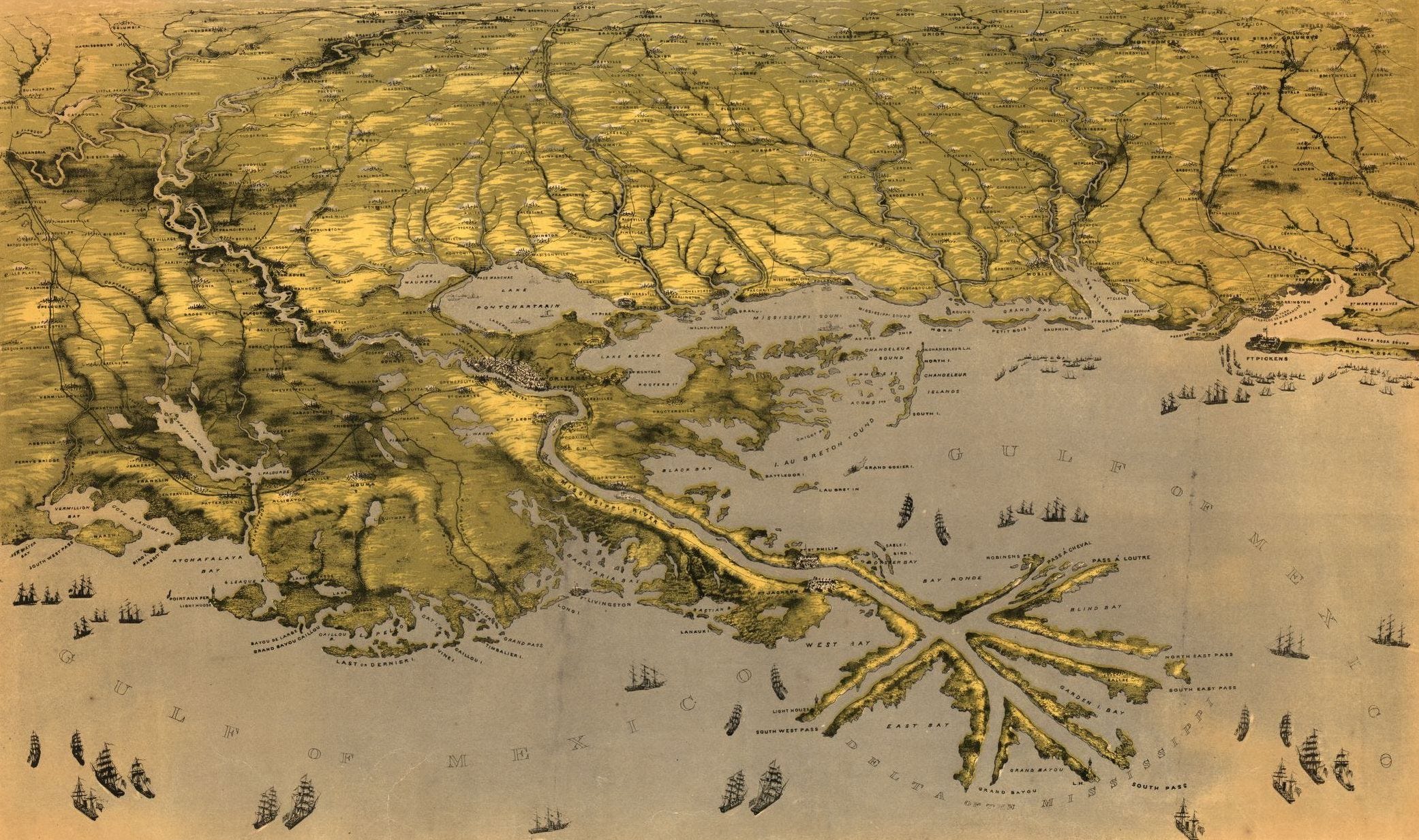





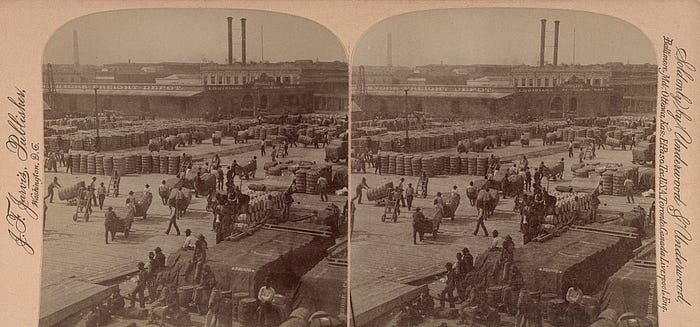



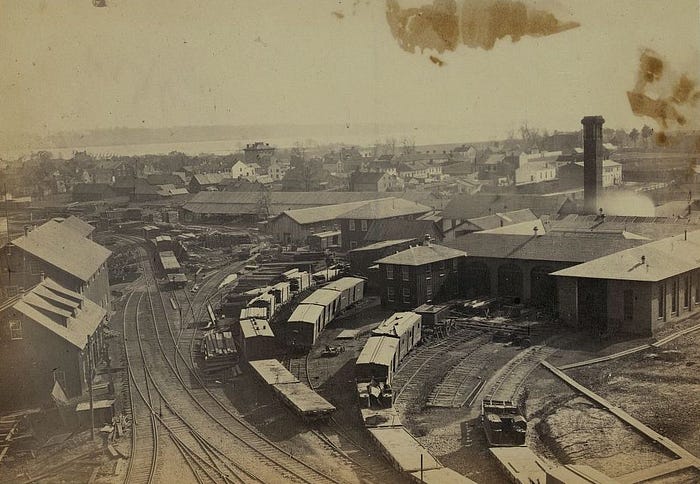







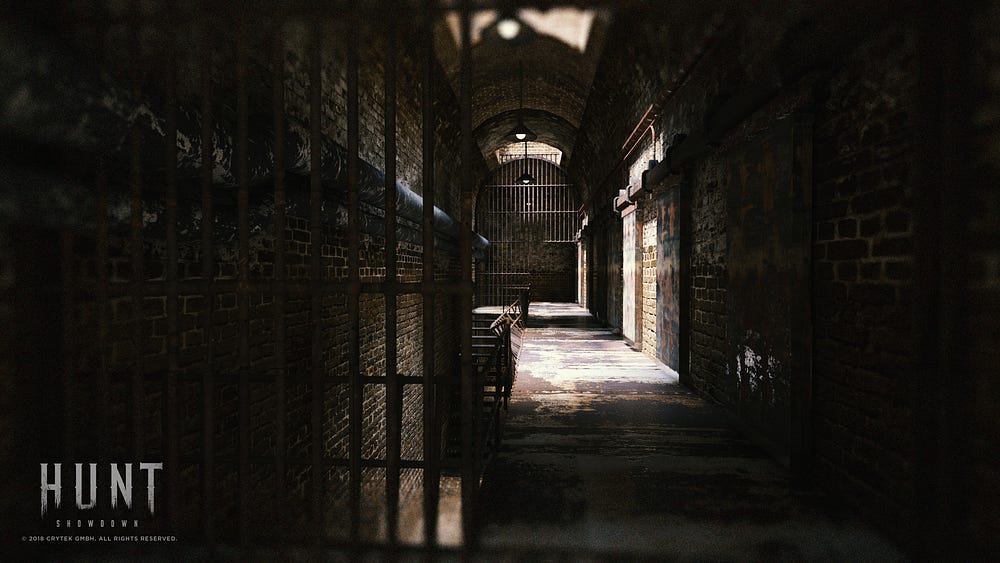
2.2. New fauna
Currently hostile animals in the world of Hunt: Showdown include stray dogs (operating in small packs), leeches (amphibians) and a particular aquatic creature with tentacles; all have the ability to inflict lethal damage to the player. There are also other examples of dogs (inside an enclosure), crows (in small flocks), and single dying horses, capable of reacting by making noises when reached by the player, thus revealing its position to surrounding enemies.


It is possible to imagine the integration of additional animals coherent with the real local fauna of the Louisiana swampy areas, possibly also imagining phenotypic mutations and additional peculiar characteristics (changes in size, resistance, mode of attack, interspecies hybrids).
Depending on the location, the new fauna may include:
- Alligators
They inhabit the marshy areas and the aquatic banks. They can inflict fatal damage both in water and on land.


- Turtles and frogs
High resistance to bullets (tortoises) or high attack speed (frogs and toads), force you to perform evasive maneuvers on the banks and attack in the water dealing poisoning damage.

- Snakes and salamanders
Present near trees, tall grass and rocky debris, they cause poisoning damage. - Wolves
Aggressive, they move in packs and strike only at night. It is also possible to imagine the presence of anthropomorphic wolves, similar to werewolves.


- Black bears
Imposing animal, it inflicts deadly damage and requires a high expenditure of ammo to take down.


- Vultures
Capable of surprise attacks from the sky, they can reduce visibility and cause bleeding damage.

- Rats
Iconic animals traditionally associated with epidemics, they move in groups and are excellent swimmers. It is possible to imagine numerous hordes, and individual creatures of various sizes, even abnormal.


- Bats
An iconic animal associated with the esoteric lore of vampires, it could be a great candidate as a future legendary monster.
2.3. New enemies
Current human hostile entities include mutant beings with sidearms and torches, with the exception of three subjects (Hive, Immolator, Meathead) with additional abilities to inflict distinctive poisoning and combustion damage. Then there are the legendary monsters, or the fundamental enemies at the completion of each hunting mission: The Butcher (anthropomorphic with swine features), The Spider (a giant spider), The Assassin (a demon made up of a swarm of insects) and Scrapbeak ( anthropomorphic with raven features, presented as a Confederate soldier wounded in war then changed into a monster).

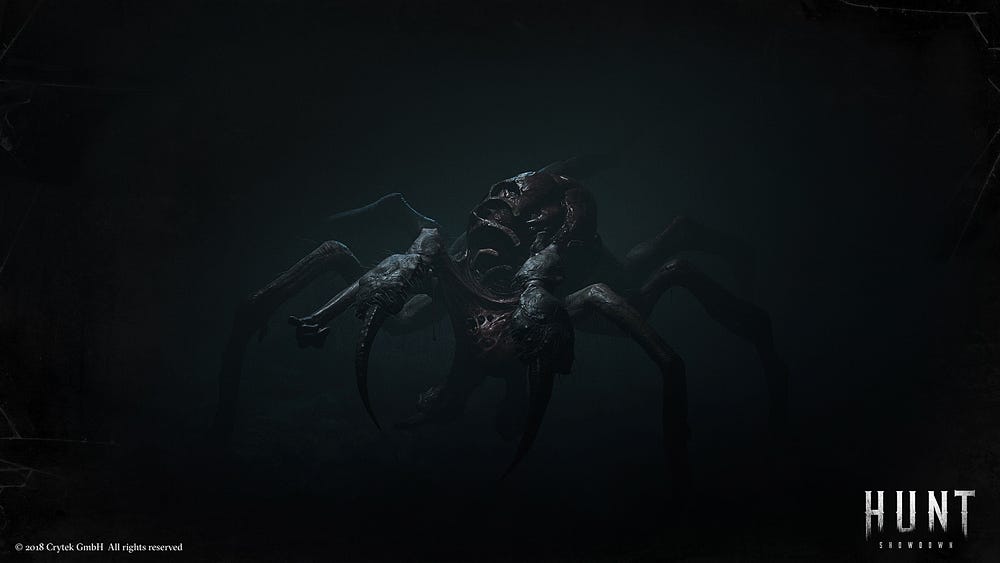


The diversification of the enemies allows to associate new locations, new gaming skills and new narrative backstories, expanding the immersive knowledge of the fictional world from an encyclopedic perspective. The future addition of new enemies is therefore to be considered as a narrative opportunity (helping to gradually reveal the background of the generative catastrophe), but above all as an interactive opportunity, involving the player to experiment with alternative skills and new combat strategies to optimize the resources (weapons, ammunition, medicines) based on the scenarios presented.
A related discourse also concerns the possibility of introducing, for example, armed antagonists. It is obvious that this variable should be carefully calibrated, since the introduction of hostile entities capable of medium-range attacks (eg: mutant soldiers armed with firearms) could cause radical changes, with the potential risk of negatively distorting the balance of the whole gaming experience.

2.4. Vehicles
Currently, the vehicles available in Hunt: Showdown have a purely decorative function, as they symbolically allow players to escape from the war zone at the end of the competition. The possible integration of vehicles (civil, military, maritime), intact or repairable, can revolutionize the ability to move (reducing distances, changing reaction times and itineraries, facilitating territorial explorations), the chances of survival (search for resources, defensive and offensive) and eventually determine specific game modes and missions. Obviously, this characteristic must also be carefully evaluated to keep the competition equilibrium functional.




2.5. Improved User Interface
The study of the game interface is naturally a complex design issue that involves numerous reflections and professional figures with specific skills. Here, I limit myself to proposing a limited and partial observation relating to those visual elements present during the game sessions with the function of favoring the visualization of tactical information to the player (compass, health, sight, ammunition, weapons and other indicators).
Although the settings allow the player to reduce the actual size of the game interface, thus reducing its physical footprint, and possibly even decide to eliminate the interface entirely, I suggest some simple personal observations to evaluate possible collateral optimization interventions when UI is maintained:
- Sight
Currently, the “guide” sight suggested to the player when holding a firearm is represented with clear lines, highly invasive as they are presented in contrast with the other information elements represented in the interface, all accurately reproduced with a wear effect on the traits respecting the historical context of the narrative world as a further immersive detail. It could therefore be preferable to represent with the same irregular strokes also the sights of the firearms and the other symbols confirming the killings, currently inconsistent with the visual representation system adopted for the other elements (this difference is instead correctly explained on the sign used for signal the position of an enemy, with an inverted triangle).

- Compass
The same graphic inconsistency reported for the representation of the sight is also found in the display of the compass, placed at the top and centrally, currently characterized by perfectly clear signs and typographical characters, and therefore in conflict with the worn lines adopted for other information elements.

- Ammunition
The current representation of firearm magazines involves the presence of circular icons to display the bullets still available in the weapon. Their usefulness is questionable. In fact, it should be investigated whether this visualization actually entails a tactical awareness benefit to the player or whether it constitutes a superfluous element. It is therefore possible to imagine an alternative solution by keeping the simple numerical representation of the ammunition and freeing the interface from circular elements.

- Health
The player’s current energy bar is placed in the center of the screen and can affect the visibility of the surrounding space. Given the presence of the red color to make the player aware of their state of health, it is perhaps possible to intervene by first reducing the thickness of the bar, and possibly reflecting on the conversion of the element into a circular shape (the vital energy of monsters represented by a rhomboid figure), while maintaining the characteristic segments for the different types of damage.

- Weapons equipped
The current representation through realistic illustration of the weapons supplied to the player imposes an important clutter on the interface. Considering that each player is aware of their equipment in use and of the recharge notifications, it is perhaps possible to apply a simplification of the images in the form of a monochrome icon, or preferably, to consider the possible complete removal of this type of displayed panel.

- Orientation texts
To indicate doors and interactive objects (lamps, traps), the presence of instructional texts can constitute an element of distraction and visual clutter. Where possible it is preferable to replace all textual information with related intuitive icons, possibly accompanied by a single word.
In conclusion, Hunt: Showdown represents a relevant sectorial testimony to reflect on the design of narrative worlds and intellectual properties with high immersive potential. Despite an apparent minimalist narrative architecture (that is: a bounty hunter operating in a limited location with a limited number of antagonists with the primary objective of killing some mutant creatures), Crytek’s project responds to excellent immersion requirements: diversified geographical locations, numerous types of enemies, opposing factions and an original mystery (the epidemic) are the ideal source for building interdependent narratives, both in the videogame field (for example by creating a new single-player adventure or in cooperative mode), and to design related expansions literary, comic, film and television.
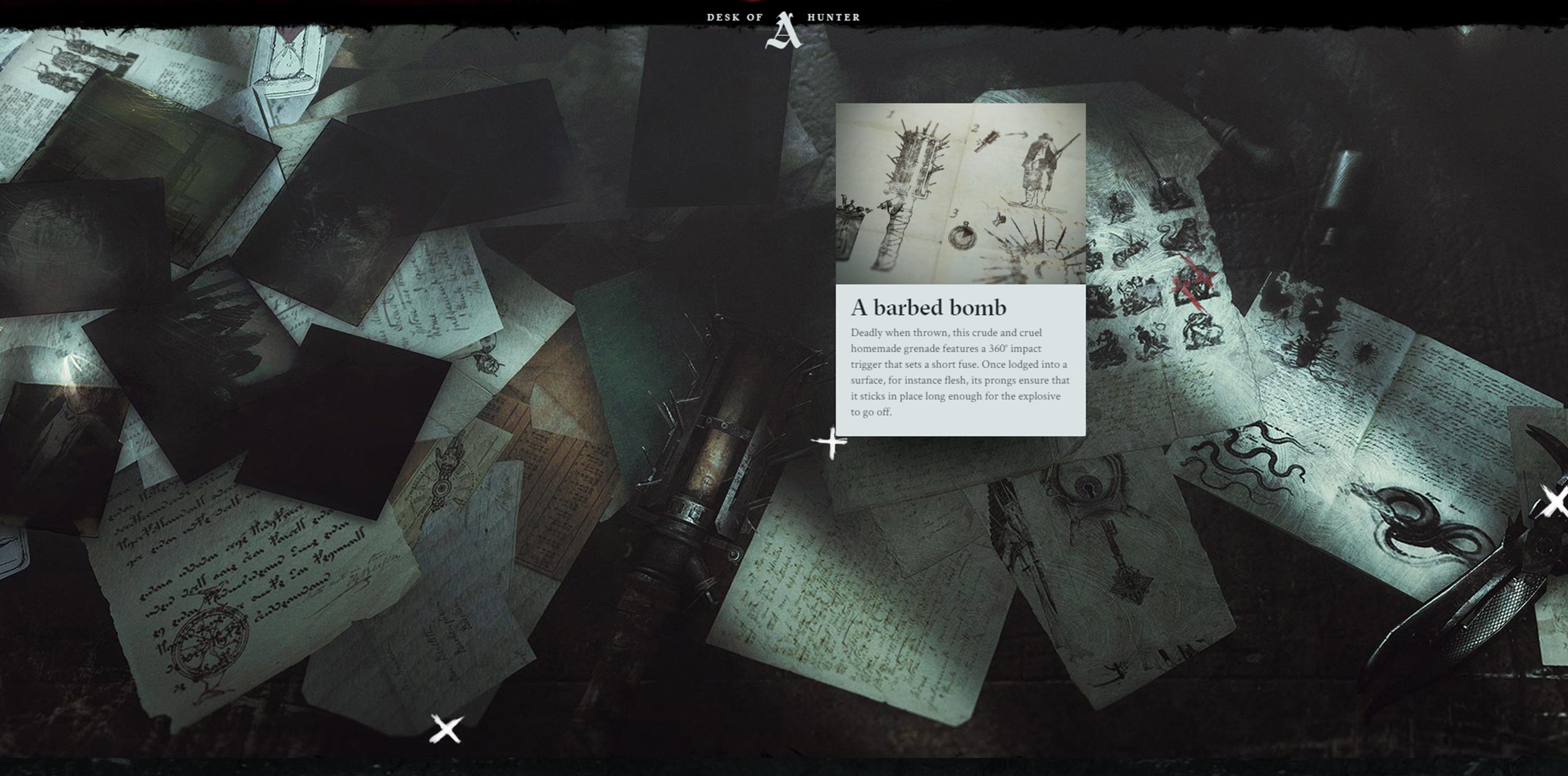



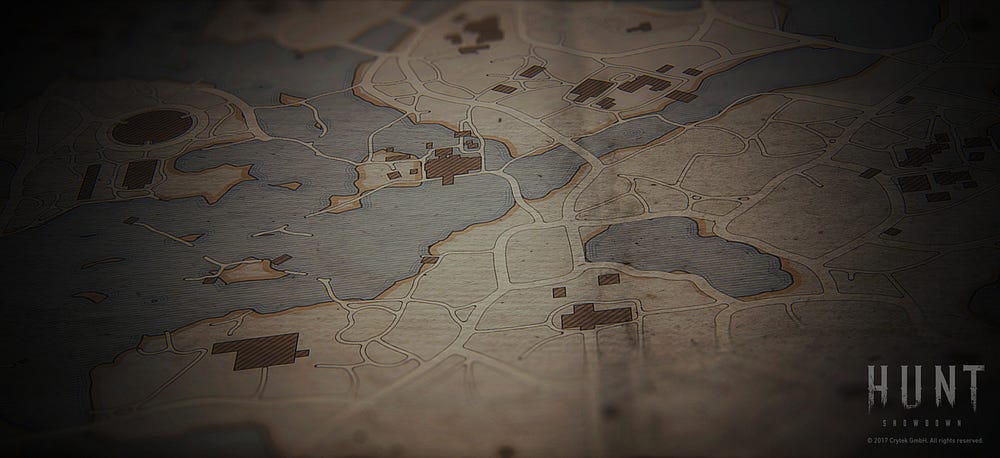
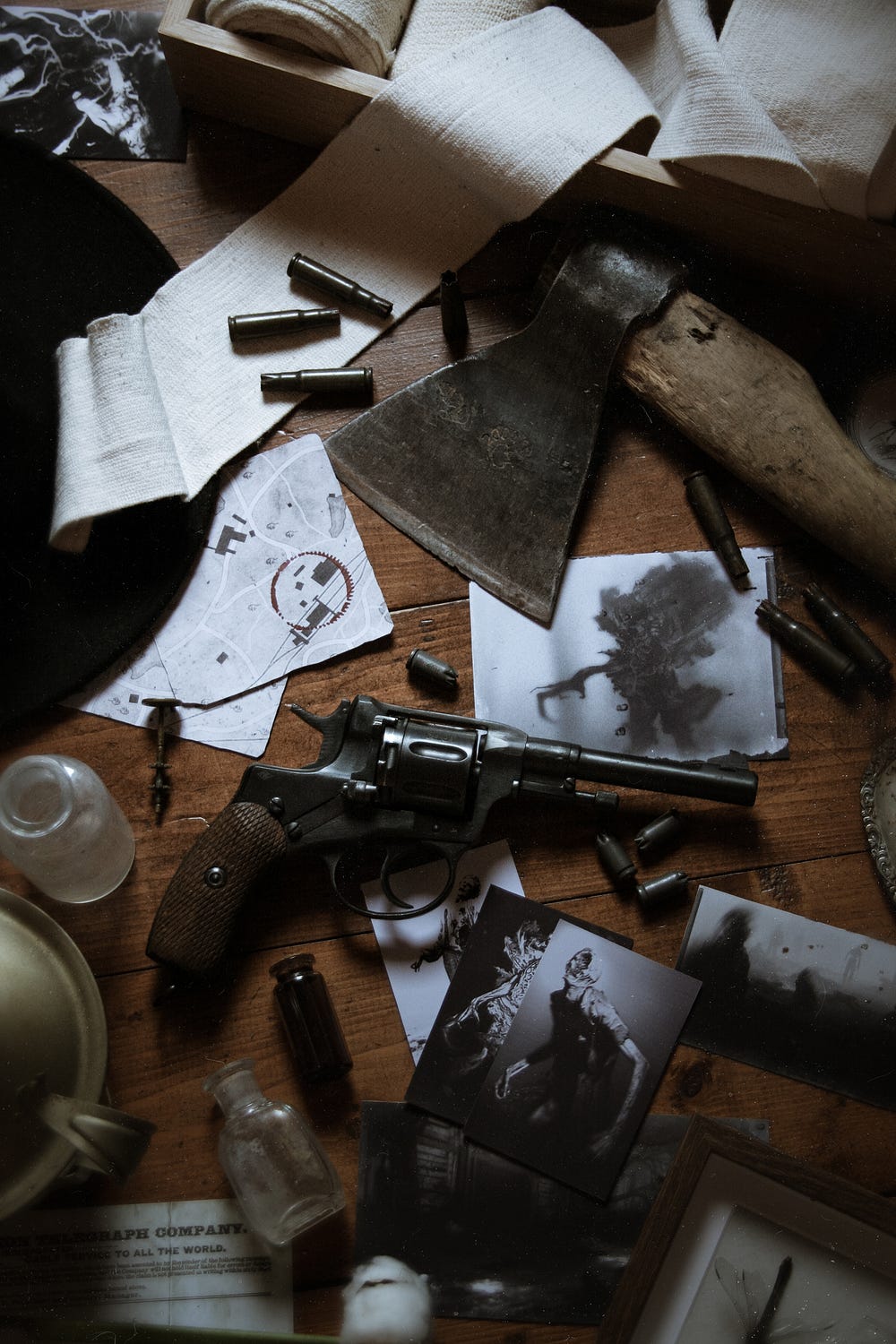
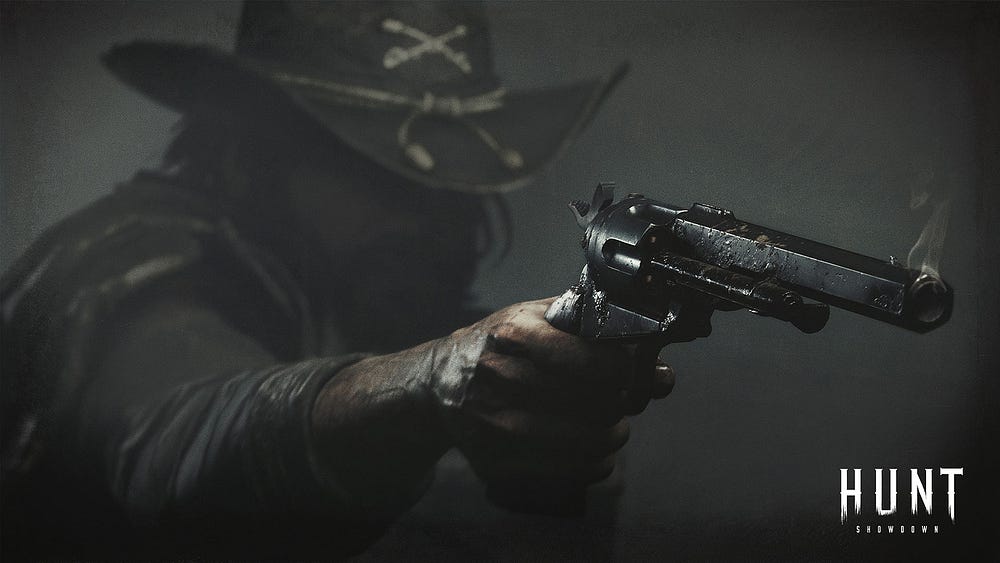
Legal notice
The iconographic material, the trademarks (registered or unregistered) and all the information reported as being in any case protected belong to the respective owners. The internal use of protected material responds exclusively to a scientific and cultural intent.
The author releases the document through the license:
- Creative Commons BY-NC-SA 4.0.
This allows third parties to share the published material indicating the origin, respecting the same type of original license and prohibiting the use for commercial purposes.
Contacts
Humenhoid is a creative research unit specialized in immersive entertainment and transmedia storytelling, with focus on cinema, tv series, and video games.
For information, communications or proposals for collaboration write to
Enrico Granzotto | e@humenhoid.com | Humenhoid.com |
Humenhoid’s projects include:
